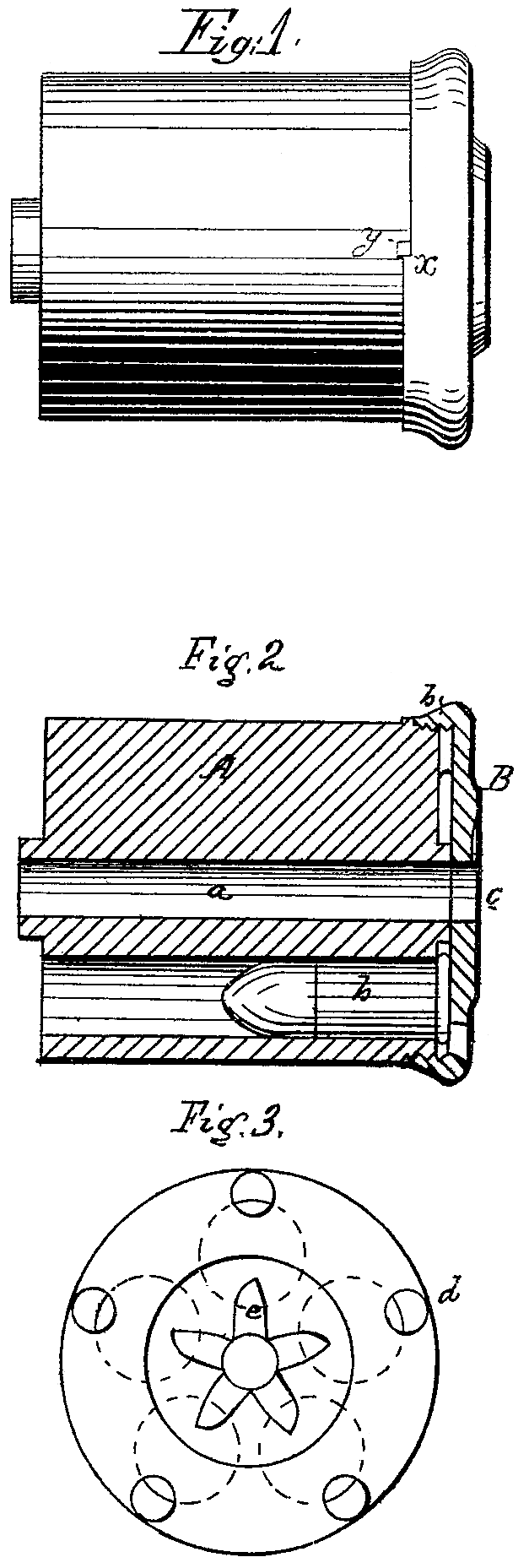US 30765
UNITED STATES PATENT OFFICE.
CHRISTIAN SHARPS, OF PHILADELPHIA, PENNSYLVANIA.
IMPROVEMENT IN REVOLVING BLOCKS OF REVOLVING FIRE-ARMS.
Specification forming part of Letters Patent No. 30,765, dated November 27, 1860.
To all whom it may concern:
Be it known that I, Christian Sharps, of the city of Philadelphia and State of Pennsylvania, have invented a new and useful Improvement in Revolving Fire-Arms; and I do hereby declare the following to be a full, clear, and exact description of the same, reference being had to the accompanying drawings, and to the letters of reference marked thereon.
My invention relates to an improvement in that class of revolving breech-blocks which are made in detachable pieces for the purpose of inclosing the enlarged ends of metallic cartridges and allowing the spent cartridges to be readily withdrawn; and my improvement consists of a breech-block and a detachable cap for the same, the latter being so adapted to the former that when the two are fitted together they shall become temporarily a permanent portion of each other, the cap being incapable of yielding to the reaction caused by the explosion of the cartridge, as in other breech-blocks made of detachable pieces, which separate when the discharge takes place, and there by interfere with the ready revolving of the block.
In order to enable others skilled in the art to make and use my invention, I will now proceed to describe its construction and operation.
On reference to the accompanying drawings, which form a part of this specification, Figure 1 is an exterior view of the breech-block of a revolver with my improvement; Fig. 2, a longitudinal section of Fig 1, and Fig. 3 a rear end view of the revolving breech.
Similar letters refer to similar parts through out the several views.
A represents the breech-block of a revolving fire-arm, the said block having the usual orifice, a, for the reception of the breech-pin, and having in the present instance five bores, which are adapted to receive the ordinary metallic cartridges, b, circular recesses being cut in the end of the block for the reception of the flanges or enlargements formed at the rear ends of cartridges of this class. On the edge of the block, at the rear end of the same, is cut a screw-thread, adapted to a similar thread cut on the inside of the flange b of the cap B, which has a central opening, c, forming a continuation of the opening a in the block for the reception of the breech-pin. The cap has also a series of openings, d d, corresponding in number to that of the bores in the block. When the cap is screwed to its proper place on the end of the block the enlarged ends of the cartridges are entirely inclosed, with the exception of such portion of each cartridge as is of necessity exposed at each opening d, through which the end of the hammer must pass for the purpose of striking the end of the cartridge and exploding the detonating material contained within the same.
In order that the cap, on being replaced after withdrawal, may always assume its proper position on the block, a collar or catch, x, Fig. 1, is formed on the flange b of the cap, and this catch bears against a stop, y, attached to or otherwise formed on the block, when the cap has been turned to its proper position, so that each hole d may expose a suitable portion of the surface of the enlarged end of one of the cartridges. The back of the cap is furnished with proper notches, e, for receiving the end of the dog by which the block is revolved during the cocking of the hammer.
I am aware that the breech-block of a revolver has been heretofore made in detachable pieces, so as to inclose the enlarged ends of metallic cartridges and at the same time to allow for their withdrawal. The pieces composing the block, however, have been hitherto held together by the frame of the fire-arm only, so that the explosion of the cartridge causes that separation of the pieces. This I have been desirous of avoiding, inasmuch as one portion of the block on the discharge of the cartridge is driven hard against one side and the other hard against the opposite side of the frame within which the block has to revolve. At the same time the expansion of the metal case of the discharged cartridge prevents the pieces composing the block from recovering their proper relative position. In other words, the block becomes so jammed as to render it a matter of great difficulty to turn it by the cocking of the hammer.
In my improvement the cap, when adjusted to its place, becomes a permanent part of the block and effectually resists the reaction caused by the explosion of the cartridges. At the same time it affords every facility for the withdrawal of the spent cartridges.
It will be evident that in place of the screw-thread other well-known mechanical appliances may be used for attaching the cap to the block for the purpose of arriving at the result desired.
Without claiming broadly a revolving breech-block furnished with a detachable cap, I claim as my invention and desire to secure by Letters Patent—
The breech-block A and detachable cap B, when the latter is so adapted to the former that when the two are fitted together they shall become temporarily a permanent portion of each other, as and for the purpose herein set forth.
In testimony whereof I have signed my name to this specification in the presence of two subscribing witnesses.
CEHRISTIAN SEHARPS.
Witnesses:
Henry Howson,
John White.

